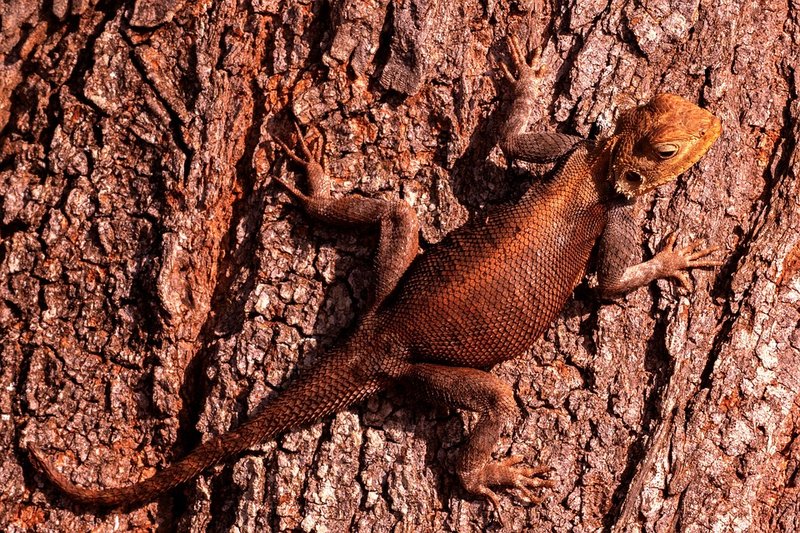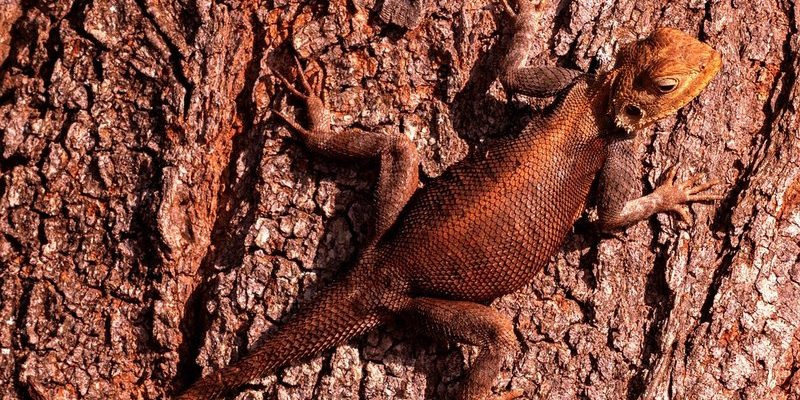
The Agama Lizard is a fascinating creature that brings a splash of color to the world of reptiles. With its vibrant hues, this lizard has captured the hearts of many nature enthusiasts. Often found basking in the sun, these lizards are not just pretty to look at; they are also intriguing in their behavior and lifestyle. As you dive into the life of the Agama Lizard, you’ll discover its unique traits, habitats, and social dynamics, which make it stand out among other reptiles.
Imagine sitting in a sunny garden, and there’s this small lizard with striking colors darting about. That’s likely an Agama! They are generally small, with a length ranging from about 10 to 20 inches, depending on the species. These lizards are typically found in Africa and parts of Asia, making them an integral part of their ecosystems. Each species boasts its own unique patterns and colors, often used for communication and mating. So, let’s explore what makes the Agama Lizard so special!
Physical Characteristics of the Agama Lizard
Agama Lizards come in a variety of colors and patterns, which can be one of their most striking features. Males often display brighter colors than females, especially during mating season. Imagine vibrant blues, vivid greens, and sunny yellows—all interspersed with earthy browns and grays. These colors aren’t just for show; they play a crucial role in attracting mates and warding off rivals. Some species can even change color depending on their mood or environmental conditions, much like a chameleon!
In terms of size, these lizards can vary significantly. Most adult Agama Lizards typically grow to be about 8 to 12 inches long, but some species can reach up to 20 inches! Their bodies are generally slender, with a long tail that aids in balance and agility. This long tail is also valuable for escaping predators. When threatened, an Agama may perform a quick *tail whip* or even drop its tail to distract a predator while it makes its escape. Fascinating, right?
Habitat and Distribution
You’ll mostly find Agama Lizards in warm, sunny areas, as they thrive in hot climates. They inhabit a range of environments, from arid deserts to grasslands and even rocky areas. Their preference for open spaces helps them bask in the sun and easily spot potential threats. They are particularly common in sub-Saharan Africa, where the landscape offers both the warmth they love and plenty of opportunities for foraging.
These lizards often create burrows or occupy crevices in rocks to escape the heat during the hottest parts of the day. They’re quite adaptable, which is key for survival in varying environments. You might even spot them in urban areas, taking advantage of the warmth from buildings and paved surfaces. Still, their natural habitats are crucial for their health and reproduction, making it essential to protect these environments from human interference.
Diet and Feeding Habits
The Agama Lizard is a carnivorous creature, feeding primarily on insects. Think about the crunch of a cricket or the flutter of a fly; these critters don’t stand a chance against a hungry Agama. They also enjoy other small invertebrates like grasshoppers, beetles, and even caterpillars. Their sharp eyesight allows them to spot prey from a distance, and then they quickly dart in to catch their meal with their agile bodies and sharp teeth.
Occasionally, Agama Lizards may consume fruits or flowers as a supplement to their diet, especially when insects are scarce. This omnivorous tendency showcases their adaptability. It’s like having a buffet at their disposal, allowing them to switch up their meals based on availability. Proper diet is essential for their well-being, providing them the energy they need for their lively antics and vibrant colors.
Behavior and Social Structure
Agama Lizards are known for their intriguing social behaviors. Unlike some solitary reptiles, these lizards can often be found basking together in groups. Males, in particular, can be quite territorial and often engage in displays to assert dominance. They may puff up their bodies, bob their heads, or even perform push-ups to impress females and intimidate rivals. It’s like a reptilian rock concert where everyone’s trying to show off their best moves!
During mating season, the vibrant colors of the males become even more pronounced, signifying their readiness to attract a mate. After a successful courtship, females will lay eggs in sandy nests, which they dig out themselves. Once the eggs hatch, the young lizards are on their own, showcasing a natural instinct to survive right from the start. This survival instinct is remarkable and is a testament to their evolutionary adaptations.
Conservation Status
The conservation status of Agama Lizards can vary significantly between species. While many of them are abundant in their natural habitats, others face threats due to habitat loss, climate change, and human activities. Urban development can disrupt their homes, making it harder for them to find food and bask in sunlight. Some species also face the threat of illegal capture for the pet trade.
Conservation efforts are crucial to ensuring that these colorful lizards continue to thrive in the wild. Awareness about their habitats and the challenges they face can help protect them. It’s essential for us to support initiatives that preserve their natural environments, such as creating protected areas and promoting sustainable land use practices. By doing so, we can ensure that future generations of Agama Lizards can enjoy the sun just like their ancestors.
Interesting Facts about Agama Lizards
| Scientific Name: | Agamidae |
| Size: | 8 to 20 inches |
| Diet: | Carnivorous (insects, small invertebrates) |
| Habitat: | Tropical and savannah regions |
| Lifespan: | 5 to 10 years in the wild |
| Color Change: | Yes (in some species) |
| Social Behavior: | Social, often bask in groups |
FAQ
What is the average lifespan of an Agama Lizard?
The average lifespan of an Agama Lizard varies depending on the species and environmental conditions. In the wild, they typically live between 5 to 10 years. Factors like habitat quality, food availability, and predation play significant roles in their longevity. In captivity, with proper care, they can live longer, possibly even exceeding 10 years.
Are Agama Lizards good pets?
Agama Lizards can make interesting pets for reptile enthusiasts, but they require specific care to thrive. They need a spacious terrarium with proper heating and lighting, a varied diet, and a habitat that mimics their natural environment. While they can be handled and may become accustomed to their owners, they are still wild animals and should be treated as such.
Do Agama Lizards change color like chameleons?
While Agama Lizards can change color to some extent, it’s not as dramatic as the color-changing abilities of chameleons. Their color changes are usually related to mood, temperature, or reproductive displays. For example, during mating season, males might show brighter colors to attract females or assert dominance over other males.
What should I feed my Agama Lizard?
Agama Lizards primarily eat insects, so a diet rich in crickets, mealworms, beetles, and other small invertebrates is ideal. You can also offer them small pieces of fruit or vegetables as a supplement. It’s crucial to provide a balanced diet to keep them healthy and vibrant.
Where do Agama Lizards live?
Agama Lizards are commonly found in warm regions, particularly in sub-Saharan Africa. They prefer habitats like grasslands, rocky areas, and even urban environments where they can bask in the sun and find food. Their adaptability allows them to thrive in various settings.
How do Agama Lizards defend themselves?
Agama Lizards have several methods of self-defense. They can run quickly to escape predators, and some species can drop their tails to distract attackers. Additionally, their bright colors and displays can help deter potential threats by signaling that they are not easy prey.
Are Agama Lizards social animals?
Yes, Agama Lizards are generally social creatures, often found basking in groups. This social behavior can help them stay safe from predators, as there’s safety in numbers. They communicate through body language and displays, which are essential for establishing territories and attracting mates.
Can Agama Lizards be found outside Africa?
While they are predominantly found in Africa, some species of Agama Lizards have been introduced to other regions, including parts of Asia. These introductions can occur through the pet trade or other means. However, their natural habitats and diversity are primarily concentrated in Africa.
How do Agama Lizards reproduce?
Agama Lizards reproduce by laying eggs. Males engage in courtship displays to attract females, and after mating, females will find a suitable spot to lay their eggs, usually in sandy soil. Once the eggs hatch, the young lizards are independent and must fend for themselves from the very beginning.
Are Agama Lizards endangered?
The conservation status of Agama Lizards varies by species. Some populations are stable, while others may be threatened by habitat loss and the pet trade. It’s important to be aware of local regulations and conservation efforts to help protect these beautiful reptiles.
What temperature do Agama Lizards need to thrive?
Agama Lizards thrive in warm environments, typically requiring temperatures between 85°F to 95°F (29°C to 35°C) in their basking areas. A proper temperature gradient in their habitat is essential for their health, allowing them to regulate their body temperature effectively.

